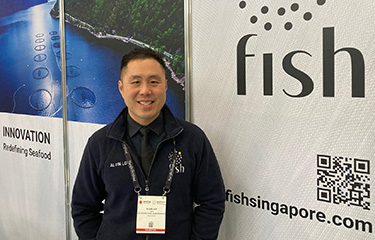Fish International Sourcing House (FISH) CEO Alvin Loy has been in the seafood industry for 23 years, and has run his own business for 18 of those.
Now doing around USD 100 million (EUR 93 million) in annual sales, Loy has grown the Singapore-based seafood importer, processor, and exporter into a multinational corporation, with processing facilities producing more than 24,000 metric tons of seafood in Singapore, China, Malaysia, and Indonesia, and global sales markets smattered across 90 countries on six continents.
“It was just a matter of starting small and growing together with our suppliers and our buyers,” Loy told SeafoodSource at the 2023 Seafood Expo North America.
Loy started in the seafood industry working in a tuna factory in Vietnam. Eight years there taught him a lot about fish processing and global sales, he said.
“Then it came time for me to step out and I started my current company,” he said.
Since 2004, FISH has expanded to sell a wide variety of products, though primarily premium-level seafood such as Patagonian toothfish, yellowfin tuna, mahi, snapper, grouper, kingfish, and squid, to wholesalers and distributors in markets as diverse as Japan, North America, South America, the Middle East, and China.
“We work very closely with fishing companies and farms, relying on the relationships built over the years,” Loy said. “To continue to grow as we have, you need to trust the company and the people you’re dealing with. Many suppliers and buyers have become my good friends, my family. Trust goes a long way in this business.”
Maintaining those relationships in an increasingly fractured global trading situation is a delicate dance, Loy said. But he said all of his customers have common needs, topped by quality and consistency in supply.
“That's always what customers demand,” he said.
Logistical and demand issues spawned by the Covid pandemic and then post-pandemic inflation made it harder to deliver, Loy said.
“The challenge for everybody across the whole value chain, from fishing to manufacturing to trading to distribution, is having no disruptions in the supply chain. In the past, we were producing just-in-time, so we are getting orders in and buying enough product just to [fulfill those orders]," he said. "But now, we have to produce just-in-case – just in case something happens, just in case product runs out, just in case there's a huge demand. So we're keeping more inventory and giving ourselves a bigger buffer.”
Loy said he has observed yet another shift in buying preferences within the past year, beyond slumping demand due to inflation, which has caused his sales to drop, including a 20 percent decline in North America.
“Now with Covid behind us, I think a lot of customers are also seeking stability. In the past 20 years, we have diversified our sources and we have a good network of suppliers and buyers,” he said. “Another thing is I think all customers now are very particular about sustainability. They're concerned about the sourc[ing] of the raw materials. So more and more we are trying to buy from much more sustainable sources which are [Marine Stewardship Council]- and [Aquaculture Stewardship Council]-certified.”
Loy said it’s a misconception that ...
Photo courtesy of Cliff White/SeafoodSource








